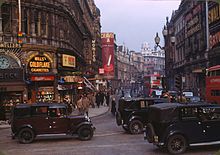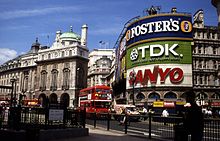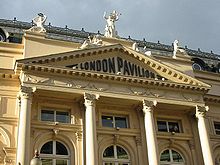Piccadilly Circus
| Piccadilly Circus | |
|---|---|
The Haymarket, Coventry Street and Glasshouse Street | |
| Construction | |
| Type | Road junction |
| Opened | 1819 |
Piccadilly Circus is a road junction and public space of London's West End in the City of Westminster. It was built in 1819 to connect Regent Street with Piccadilly. In this context, a circus, from the Latin word meaning "circle", is a round open space at a street junction.[1]
The Circus now connects Piccadilly, Regent Street,
It is surrounded by several notable buildings, including the London Pavilion and Criterion Theatre. Underneath the plaza is Piccadilly Circus Underground station, part of the London Underground system.
History






Piccadilly Circus connects to Piccadilly, a thoroughfare whose name first appeared in 1626 as Piccadilly Hall, named after a house belonging to one Robert Baker, a tailor famous for selling piccadills, or piccadillies, a term used for various kinds of collars. The street was known as Portugal Street in 1692 in honour of Catherine of Braganza, the queen consort of King Charles II but was known as Piccadilly by 1743. Piccadilly Circus was created in 1819, at the junction with Regent Street, which was then being built under the planning of John Nash on the site of a house and garden belonging to a Lady Hutton; the intersection was then known as Regent Circus South (just as Oxford Circus was known as Regent Circus North) and it did not begin to be known as Piccadilly Circus until the mid 1880s, with the rebuilding of the Regent Street Quadrant and the construction of Shaftesbury Avenue. In the same period the circus lost its circular form.[3]

The junction has been a very busy traffic interchange since construction, as it lies at the centre of
Piccadilly Circus tube station was opened on 10 March 1906, on the Bakerloo line, and on the Piccadilly line in December of that year. In 1928, the station was extensively rebuilt to handle an increase in traffic. The junction's first electric advertisements appeared in 1910, and, from 1923, electric billboards were set up on the facade of the London Pavilion. Electric street lamps, however, did not replace the gas ones until 1932.[4] The circus became a one-way roundabout on 19 July 1926.[5] Traffic lights were first installed on 3 August 1926.
During World War II many servicemen's clubs in the West End served American soldiers based in Britain. So many prostitutes roamed the area approaching the soldiers that they received the nickname "Piccadilly Commandos", and both
At the start of the 1960s, it was determined that the Circus needed to be redeveloped to allow for greater traffic flow. In 1962,
The Holford plan is referenced in the short-form
The Circus has been targeted by
The
Location and sights
Piccadilly Circus is surrounded by tourist attractions, including the

Illuminated signs

Piccadilly Circus was surrounded by illuminated advertising hoardings on buildings, starting in 1908 with a
The earliest signs used
Until the 2017 refurbishment, the site had six LED advertising screens above three large retail units facing Piccadilly Circus on the north side, occupied by
- Coca-Cola has had a sign at Piccadilly Circus since 1954.[16] In September 2003, the previous digital projector board and the site that had been occupied by Nescafé was replaced with a state-of-the-art LED video display that curves round with the building. Before Nescafé, a neon advertisement for Foster's occupied the spot from 1987 until 1999, and from 1978 to 1987 it was used by Philips Electronics. For several months in 2002, the Nescafé sign was replaced by a sign featuring the quote "Imagine all the people living life in peace" by Beatle John Lennon. This was paid for by his widow Yoko Ono, who spent an estimated £150,000 to display an advert at this location.[17] Coca-Cola, Diet Coke, Coca-Cola Zero, Fanta, Sprite and Vitamin Water have all been advertised in the space.
- Hyundai Motors sign launched on 29 September 2011.[18] It replaced a sign for Sanyo which had occupied the space since around early 1988 (slightly modified in 2004), the last to be run using neon lights rather than Hyundai's computerised LED screen. Earlier Sanyo signs with older logos had occupied the position since 1978, although these were only half the size of the later space.[19]
- McDonald's added its sign in 1987, replacing one for BASF. The sign was changed from neon to LED in 2001. A bigger, brighter screen was installed by Daktronics in 2008.[20]

Piccadilly Circus during the COVID-19 lockdown in March 2020 - Samsung added its sign in November 1994,[21] the space having been previously occupied by Canon Inc. (1978–84) and Panasonic (1984–94). The sign was changed from neon to LED in summer 2005. The screen was upgraded and improved in autumn 2011.
- L'Oreal, Hunter Original and eBay both had signs in the Piccadilly circus billboards since October 2017.[22][a]
- One Piccadilly, the highest resolution of all the LED displays was installed by Daktronics, in late 2013, underneath the Samsung and McDonald's signs. It allowed other companies to advertise for both short- and long-term leases, increasing the amount of advertising space but using the same screen for multiple brands. Prior to this an earlier, smaller LED screen called Piccadilly Lite occupied the space from 3 December 2007 to 2013. The space has also been occupied by Budweiser(2003–07).
- The Curve, a similar space to One Piccadilly, was added in 2015, replacing a space previously occupied by Schweppes (1920–61), BP (1961–67), Cinzano (1967–78), Fujifilm (1978–86), Kodak (1986–90) and TDK (1990–2015).[23] Burberry was using the space as of December 2015.[citation needed]
- LG was added in February 2007 on the roof of Coventry House, which diagonally faces Piccadilly Circus.[24] Its sign is a large LED video advertising display for LGE, the British arm of the South Korean electronics group. The new display also incorporates a scrolling ticker of Sky News headlines. Before LG, Vodafonehad a neon sign installed on that spot, which displayed both its logo and personal messages that could be submitted on a special website and displayed at a certain time and date.
On special occasions the lights are switched off, such as the deaths of Winston Churchill in 1965 and Diana, Princess of Wales in 1997. On 21 June 2007, they were switched off for one hour as part of the Lights Out London campaign.[25]
Other companies and brands that have had signs on the site were Bovril, Volkswagen, Max Factor, Wrigley's Spearmint, Skol, Air India and Gold Flake (as Will's Gold Flake Cigarettes).[26]
Since 2020, the
Shaftesbury Memorial and the statue of Anteros

At the south-eastern side of the Circus, moved after
Criterion Theatre
The
The theatre was designed by Thomas Verity and opened as a theatre on 21 March 1874, although original plans were for it to become a concert hall. In 1883, it was forced to close to improve ventilation and to replace gaslights with electric lights and was reopened the following year. The theatre closed in 1989 and was extensively renovated, reopening in October 1992.
London Pavilion
On the north-eastern side of Piccadilly Circus, on the corner between Shaftesbury Avenue and Coventry Street, is the London Pavilion. The first building bearing the name was built in 1859 and was a music hall. In 1885, Shaftesbury Avenue was built through the former site of the Pavilion, and a new London Pavilion was constructed, which also served as a music hall. In 1924 electric billboards were erected on the side of the building.

In 1934, the building underwent significant structural alteration and was converted into a
Major shops
The former
Lillywhites is a major retailer of sporting goods located on the corner of the circus and Lower Regent Street, next to the Shaftesbury fountain. It moved to its present site in 1925. Lillywhites is popular with tourists, and they regularly offer sale items, including international football jerseys up to 90% off. Nearby Fortnum & Mason is often considered to be part of the Piccadilly Circus shopping area and is known for its expansive food hall.[30]

County Fire Office

Dominating the north side of the circus, on the corner of Glasshouse Street, is the County Fire Office building, with a statue of Britannia on the roof. The original building was designed by John Nash as the extreme southern end of his Regent Street Quadrant. Its dramatic façade was clearly influenced by Inigo Jones's old Somerset House. Although Robert Abraham was the County Fire Insurance Company's architect, it was probably Nash who was instrumental in choosing the design.[31] In 1924 the old County Fire Office was demolished and replaced with a similar but much coarser building designed by Reginald Blomfield, but retaining the statue of Britannia.[32] During the London Blitz it was the only building in the Circus to be damaged, with a few window panes blown out.[33] The building is Grade II listed.[34]
Underground station and the Bakerloo and Piccadilly lines

The Piccadilly Circus station on the London Underground is located directly beneath Piccadilly Circus itself, with entrances at every corner. It is one of the few stations which have no associated buildings above ground and is fully underground. The below ground concourse and subway entrances are Grade II listed.[35]
The station is on the Piccadilly line between Green Park and Leicester Square, and the Bakerloo line between Charing Cross and Oxford Circus.
Demonstrations
The Circus' status as a high-profile public space has made it the destination for numerous political demonstrations, including the
In popular culture
The phrase it's like Piccadilly Circus is commonly used in the UK to refer to a place or situation which is extremely busy with people. It has been said that a person who stays long enough at Piccadilly Circus will eventually bump into everyone they know. Probably because of this connection, during World War II, "Piccadilly Circus" was the code name given to the Allies'
Piccadilly Circus has inspired artists and musicians. Piccadilly Circus (1912) is the name and subject of a painting by British artist
See also
- Bukit Bintang, Kuala Lumpur
- Cambridge Circus, London
- Chinawhite (nightclub)
- Oxford Circus
- Punto Obelisco (Obelisk Point, Buenos Aires)
- Shaftesbury Avenue
- Shibuya Crossing, noted public space and crossroads in Tokyo
- Times Square, a noted road junction and public space in New York
- Yonge–Dundas Square, a major public square with commercial signage in Toronto
Notes
References
Citations
- ^ "circus", Oxford English Dictionary 2nd Edition 1989
- ^ Tom (16 September 2015). "Great Photo of London's Piccadilly Circus in 1908". Cool Old Photos. Retrieved 3 March 2019.
- ^ 'The rebuilding of Piccadilly Circus and the Regent Street Quadrant', in Survey of London: Volumes 31 and 32, St James Westminster, Part 2, ed. F H W Sheppard (London, 1963), pp. 85-100. British History Online http://www.british-history.ac.uk/survey-london/vols31-2/pt2/pp85-100 [accessed 26 November 2019].
- ^ Marshall 1972, pp. 139–40.
- ^ "One-Way Traffic". The Times. No. 44316. 6 July 1926. p. 11. Retrieved 24 April 2020.
- ^ Tweedie, Neil (1 November 2005). "How our Piccadilly Commandos had the GIs surrounded". The Telegraph. Archived from the original on 12 January 2022. Retrieved 21 September 2013.
- ^ Pevsner & Cherry 1973, p. 756.
- ^ "Toilet attendant saved London from IRA bomb". The Guardian. 4 February 2008. Retrieved 27 January 2019.
- ^ "CAIN: Chronology of the Conflict 1974".
- ^ "Two bombs bring chaos to London". The Independent. 8 October 1992. Archived from the original on 26 May 2022. Retrieved 27 January 2019.
- ^ Weinreb, Ben; Hibbert, Christopher (1992). The London Encyclopaedia (reprint ed.). Macmillan. p. 271.
- ^ "The rebuilding of Piccadilly Circus and the Regent Street Quadrant". British History Online. London County Council. Retrieved 25 March 2015.
- ^ "Piccadilly Lights: A timeline". The Telegraph. 29 September 2011. Archived from the original on 12 January 2022. Retrieved 25 March 2015.
- ^ "Piccadilly shows sign of the times". BBC News. 16 December 1998.
- ^ "Piccadilly Circus lights to be switched off for revamp". BBC News. 8 December 2016.
- ^ Mark Sinclair (24 June 2011). "The making of a Coca-Cola neon sign, 1954". Creative Review. Archived from the original on 20 March 2015. Retrieved 25 March 2015.
- ^ Peachey, Paul (5 March 2002). "Imagine: some peace in Piccadilly Circus". The Independent. London. Archived from the original on 26 May 2022.
- ^ Durrani, Arif (29 September 2011). "Hyundai replaces Sanyo as Piccadilly Circus advertiser". Media Week. London.
- ^ Demetriou, Danielle (16 February 2011). "Red Sanyo sign in Piccadilly Circus to be switched off". The Telegraph. London. Archived from the original on 12 January 2022.
- ^ BROOKINGS, S. D. (25 August 2009). "Interactive Display at Piccadilly Circus launches McDonald's and Daktronics in the Spotlight". Daktronics. Archived from the original on 18 September 2018. Retrieved 16 February 2016.
- ^ "한국광고신문". Archived from the original on 27 December 2008. Retrieved 2 February 2008.
- ^ "Ebay completes advertiser rooster for Piccadilly Lights relaunch". Retrieved 20 October 2017.
- ISSN 0261-3077. Retrieved 16 February 2016.
- ^ Jurrien, Ralf (14 February 2007). "LG giant LED screen in Piccadilly Circus LetsGoMobile". LetsGoMobile. Retrieved 16 February 2016.
- ^ "London lights out for environment". BBC News. 22 June 2007.
- ^ Marshall 1972, pp. 136–143.
- ^ Buck, Louisa (30 November 2022). "Circa's Piccadilly Circus billboard offers Christmas lights with a difference". The Art Newspaper - International art news and events. Retrieved 20 December 2022.
- ^ Lloyd & Mitchinson (2006) The book of general ignorance "Because of the bow and the nudity... everybody assumed it was Eros, the Greek god of love"
- ^ Pevsner & Cherry 1973, pp. 639–40.
- ^ "Things to do in London, London Events – Spoonfed". www.spoonfed.co.uk. Archived from the original on 30 April 2009. Retrieved 22 June 2009.
- ^ Hobhouse, Hermione (1975). A History of Regent Street. Macdonald and Jane. p. 47.
- ^ Marshall 1972, p. 136.
- ^ Marshall 1972, p. 141.
- ^ Historic England. "The County Fire Office (1227630)". National Heritage List for England. Retrieved 9 May 2020.
- ^ Historic England. "Piccadilly Circus Underground Station Booking Hall Concourse and Bronzework to Pavement Subway Entrances (1226877)". National Heritage List for England. Retrieved 24 January 2014.
- ^ Photograph: Andrew Parsons, PA. "West End congestion (15.02.03: Stop the war protest). Marches from two central London starting points converge at Piccadilly Circus". The Guardian. Retrieved 2 June 2017.
- ^ "Riot police in Soho as stop G8 protests start". LBC. Archived from the original on 8 April 2016. Retrieved 2 June 2017.
- ^ D-Day, The Invasion of Europe. New York, New York: American Heritage Publishing Co, Inc. 1962. p. 36.
. . .the ten-mile (16 km) circle in the Channel nicknamed Piccadilly Circus, where the troop convoys would meet . . .
- ^ The Album: A Guide to Pop Music's Most Provocative, Influential, and Important Creations. ABC-CLIO. 2012. p. 260.
- ^ "LS Lowry painting set to fetch £6m at auction". The Guardian. 2 October 2011.
- ^ "Laurence Stephen Lowry, R.A. (1887-1976) | Piccadilly Circus, London | 20th Century, Paintings". Archived from the original on 4 March 2016. Retrieved 3 November 2011.
- ^ Carl Randall paints 70 people in Piccadilly Circus., Making a Mark, Art Blog, London, 2018
- ^ Carl Randall – Piccadilly Circus painting video., Youtube, 2018, archived from the original on 17 November 2021
- ^ Carl Randall – Piccadilly Circus painting., carlrandall.com, 2018
Sources
Books
- ISBN 1-873590-04-0.
- Harris, C. M. What's in a name? The origins of the names of all stations in current use on the London Underground and Docklands Light rail with their opening dates. Midas Books and London Transport, fourth edition, 2001. ISBN 1-85414-241-0.
- Lange, D. The Queen's London: A Pictorial and Descriptive Record of the Streets, Buildings, Parks and Scenery of the Great Metropolis. Cassell and Company, London, 1896.
- Marshall, Prince Wheels of London; The story of London's street transport. ISBN 0-7230-0068-9.
- Mills, Anthony David Dictionary of London Place Names. ISBN 0-19-280106-6.
- ISBN 0-14-071012-4.
- Piccadilly Circus: From Controversy to Reconstruction. Greater London Council, 1980. ISBN 0-7168-1145-6.
Articles and websites
- Hadley, P. "Piccadilly Circus, How a typical 1906 London tube station was built", Underground News 412, April 1996.
- Jacob, S. "Review: Piccadilly Circus", Icon Magazine, November 2003.
- "London lights out for environment", BBC News, 22 June 2007
External links
- Piccadilly.london Archived 19 April 2016 at the Wayback Machine Things to do in Piccadilly area
- Theatre History
- This is London theatre guide to Criterion Theatre
- Metallurgical study of the statue of Eros following restoration in 1990
- Map from www.streetmap.co.uk Archived 14 October 2004 at the Wayback Machine
- Aerial photo from maps.google.com
- London Landscape TV episode (5 mins) about Piccadilly Circus
- The Lights of Piccadilly

